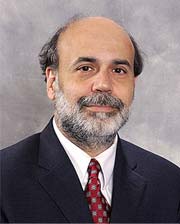|
 The US Federal Reserve's decision to leave the benchmark rate unchanged at 2 per cent is very much on expected lines. More than the decision itself, markets were eagerly waiting for the tone and language of the policy statement to gauge the mood at the Fed and for pointers to future policy direction. The US Federal Reserve's decision to leave the benchmark rate unchanged at 2 per cent is very much on expected lines. More than the decision itself, markets were eagerly waiting for the tone and language of the policy statement to gauge the mood at the Fed and for pointers to future policy direction.
Yesterday's decision was significant as it comes after a series of rate cuts since last year to stem the credit crisis and prevent the US economy from falling into a recession. Though he was widely criticised for pampering to the demands of financial markets, Fed chairman Bernanke seems to have succeeded in calming the credit market and avoiding a full blown recession. Having achieved that, he now seems guarded about the future policy direction. The policy statement
The Fed's policy statement recognises that the US economy has not slipped into recession as feared. Contrary to expectations, the GDP actually expanded in the Jan-March quarter. Though higher unemployment and oil prices have pulled down consumer sentiment, consumer spending stay above expectations and most forecasts are for a marginal GDP expansion in the second quarter as well. The Fed agrees with this assessment by saying 'overall economic activity continues to expand', whereas in the last statement the Fed was more specific and called the economy 'weak'. The statement goes on to list the factors that will affect growth in the coming quarters – high oil prices, tighter credit conditions, continuing housing market turmoil and softening labour markets. But, the Fed is confident that 'the substantial easing of monetary policy to date' and measures to ease liquidity will support growth and the downside risks to growth have diminished from the last meeting. The Fed is not yet willing to call a bottom for the credit crisis and says 'financial markets remain under considerable stress'. From the statement, it is reasonably clear that the focus has now shifted to inflation when it says 'the upside risks to inflation and inflation expectations have increased' while underplaying concerns over growth. So, while the Fed continues to expect inflation to 'moderate later this year and next year', the central bank is concerned about the inflation outlook mostly because of higher oil and other commodity prices. Outlook
It is very clear that the Bernanke has not made up his mind and this is a 'neither here, nor there' kind of assessment. Most commentators agree that there is something in the statement for everyone; the Fed is neither too worried about growth nor very alarmed about inflation. The Fed seems to be consciously tempering expectations of a rate hike anytime soon year by saying inflation will moderate later this year and next year. Though the Fed rate futures indicated the possibility of one or more rate hikes before the year end, they are now less certain. The stock market response to the Fed decision evidently marked this uncertainty. Stock prices were firm at opening and gained after the decision, only to give up and end flat. As only analyst said, the Fed statement 'strikes a tenuous balance between the wounded consumer and the spectre of commodity driven inflation'. The Fed may have to continue that balancing act for a few more months before shifting gears and start hiking rates.
|